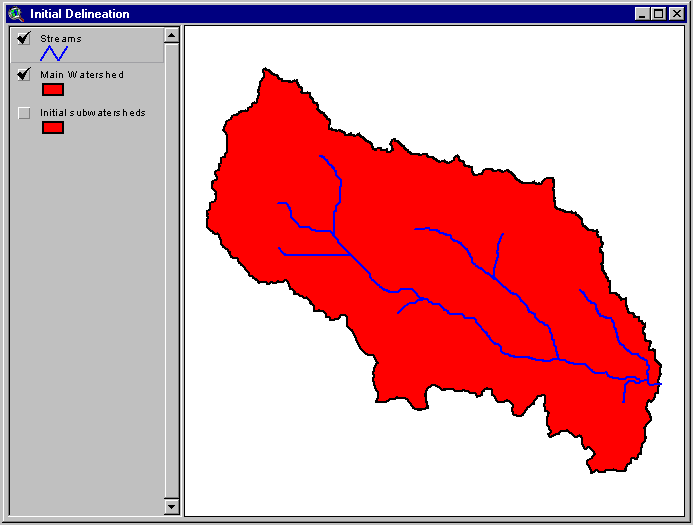
DEM Preprocessing for Efficient Watershed Delineation
Dean Djokic and Zichuan Ye
Esri
Redlands, California
Abstract
GIS is widely used to support water quantity and quality studies. GIS and digital elevation models (DEM) can be used to perform watershed delineation to a point, a reach, or an area of interest, which is usually one of the first steps in such studies. This paper presents the methodology that preprocesses the DEM in order to facilitate interactive watershed delineation. As a result, watersheds can be delineated quickly and with consistent time response, regardless of the DEM size, or the size of the resulting watershed. This methodology is used as a basis for interactive basin development in GIS tools for HMS model support.
Introduction
Watershed delineation is one of the most commonly performed activities in hydrologic and environmental analyses. Digital elevation models (DEM) provide good terrain representation from which the watersheds can be derived automatically using GIS technology. The techniques for automated watershed delineation have been available since mid-eighties and have been implemented in various GIS systems and custom applications (Garbrecht and Martz, 1999).
These techniques are independent of the DEM resolution and their use is becoming more popular with the advent of higher resolution DEMs that allow more and more detailed terrain representation and analysis. Another important role in attractiveness of these techniques is the increase in desktop computing power that allows complex operations involved in this process to be performed locally and fast enough. These two factors together with the increased emphasis in industry for watershed-wide solutions are placing increasing demands on the automated systems to provide the results quickly.
In general, the traditional approach in automated watershed delineation required high-end GIS and often resulted in long processing times (hours) and times that varied with respect to the location of the point of interest (Perez, 1999). For example, if the point of interest was close to the overall watershed boundary, the processing time would be faster than if that point was close to the watershed outlet. This was not conducive to interactive use of the methodology and limited its use to GIS shops. It also limited overall use of the methodology since the end users (people needing the watershed boundaries) were not willing to wait sometimes for days to get results from the GIS group (and then realize that some other points would be of interest and then have to wait for few more days for the results).
This paper presents the methodology for DEM preprocessing that provides the basis for fast (sub-minute) and consistent watershed delineation on DEMs of any resolution and size using desktop GIS technology. This methodology will be referred to as Fast Watershed Delineation method (FWD). It has been initially developed in 1997 (Djokic et al., 1997) as part of the watershed delineation project developed for the Texas Natural Resource Conservation Commission.
FWD Methodology
The FWD methodology is based on the following key factors:
The FWD methodology consists of two preprocessing steps and a technique for using the preprocessed data. They will be described in the following sections.
Step 1 - Determination of derived DEM properties
In this step the key terrain derivatives (flow direction and flow accumulation grids based on the elevatioin grid) are computed and saved, so when needed for individual watershed delineation they do not have to be computed again, but are directly accessed. This means that these operations need to be performed only once for a given DEM (if DEM changes, then these operations need to be repeated). This also allows the computations to be performed at a different computer than the one on which the watershed delineation will be performed. Since these computations are some of the most resource intensive, they can be delegated to the most powerful (or dedicated) machines. Once the processing is done, the results can be sent to other machines where the less intensive (and more interactive) operations will be performed.
Step 2 - Initial, arbitrary delineation
In this step the initial, arbitrary watershed delineation that will serve as the basis for interactive delineation is performed. Figure 1 depicts a large watershed with its stream network. This watershed will be subdivided into several subwatersheds to increase the performance for interactive delineation. Since the initial delineation is arbitrary, any technique producing acceptable results can be applied, so in general, the simplest GIS procedures can be applied for this task.

Figure 1. Main watershed with the stream network.
The most straightforward GIS technique for subwatershed delineation consists of the following steps (described in more detail in Esri, 1997 and Olivera and Maidment, 1999):
An overview of the process is presented in Figure 2.
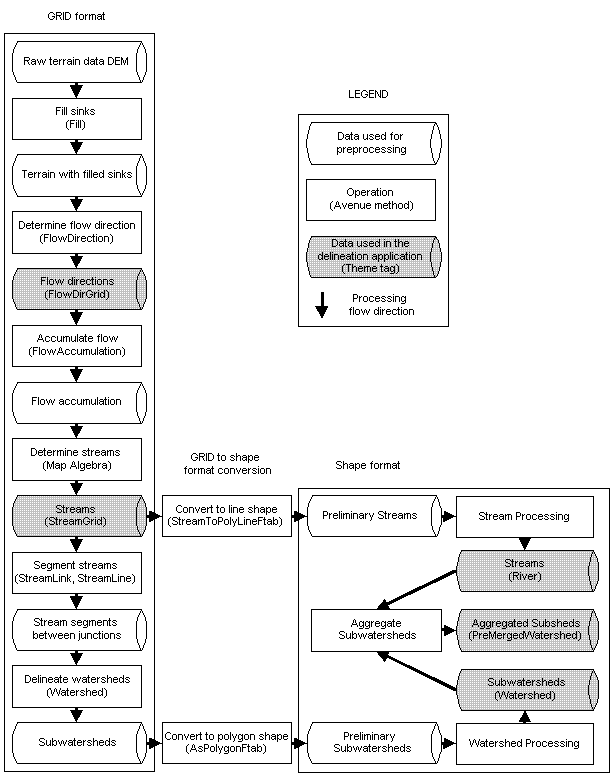
Figure 2. Processing flow for initial, arbitrary subwatershed delineation (from Esri, 1997).
The shaded elements in Figure 2 are the actual data used to support the interactive delineation. All other data are intermediate results and are actually not necessary for the watershed delineation process (although they might be needed for other hydrologic operations, e.g. DEM itself is not needed for the watershed delineation but is needed for elevation extraction). Figure 3 depicts the initial watershed broken down into a number of non-overlapping and all-inclusive subwatersheds, after applying the described procedure. In this example, there are 15 subwatersheds.
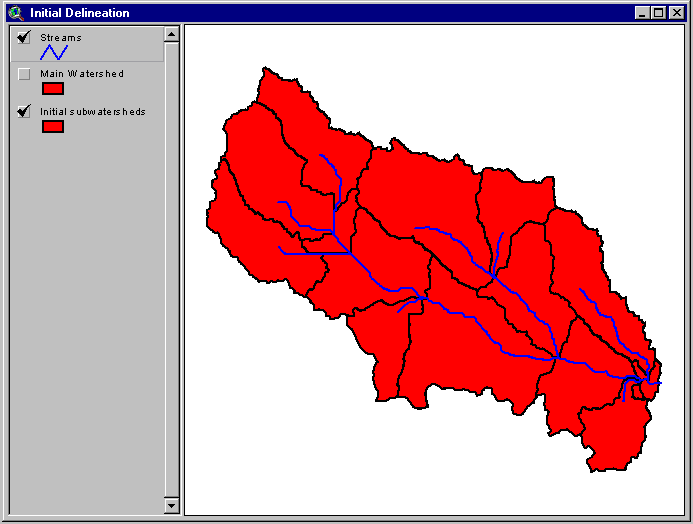
Figure 3. Subwatersheds with the stream network
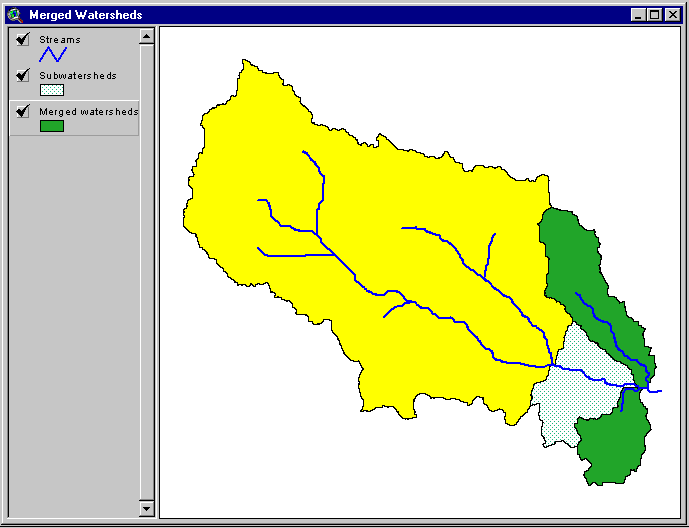
Figure 4. Example of merged upstream watershed. The dotted polygon in the middle is the subwatershed of interest. The light colored polygon to its left is the merged polygon, while the dark polygons to its right are the areas of the overall watershed not draining into it.
In addition to the polygon layer of the non-overlapping subwatershed polygons, another polygon theme is created that contains for each subwatershed, the polygon of the contributing area at its upstream end (Figure 4). This, so called "merged watershed" polygon theme, is constructed by aggregating all the upstream subwatersheds from each initial subwatershed. All of these polygons are stored in a single theme, so they are overlapping. The role of this polygon theme will be explained in the next section. Generation of the merged watershed theme concludes the DEM pre-processing steps.
Both the initial delineation and the upstream watershed merging are a one-time operation, and can be performed independently from the actual watershed delineation similarly to the determinations of derived DEM properties. It is suggested that these operations (or at least the grid processing operations) be performed at GIS shops that are equipped for large data processing and have extensive experience in DEM manipulation for hydrologic purposes. The processed data can then be published for use by general users who can skip many of the preprocessing tasks and be assured of the quality of the published work. Examples of such datasets are the Oklahoma 1:100,000 scale DEM (Cederstrand and Rea, 1995) and HYDRO 1K Elevation Derivative Database (USGS, et al.).
The preprocessed data can be hidden from the end user if necessary. Usually at least the stream network and the overall watershed boundary is displayed to provide the user with a visual reference, but other sources can be used for that purpose as well (such as DOQQs or scanned and georeferenced topo maps).
Technique for individual watershed delineation
When a total drainage area to a point needs to be identified, the following procedure is performed:
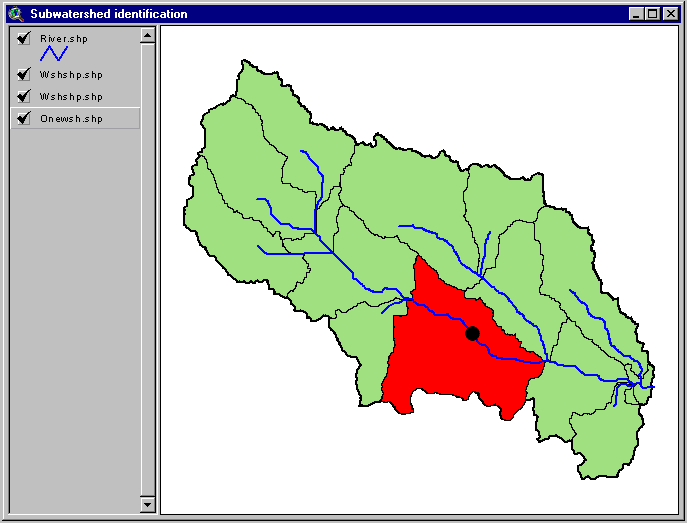
Figure 5. Identifying the subwatershed containing the point of interest.
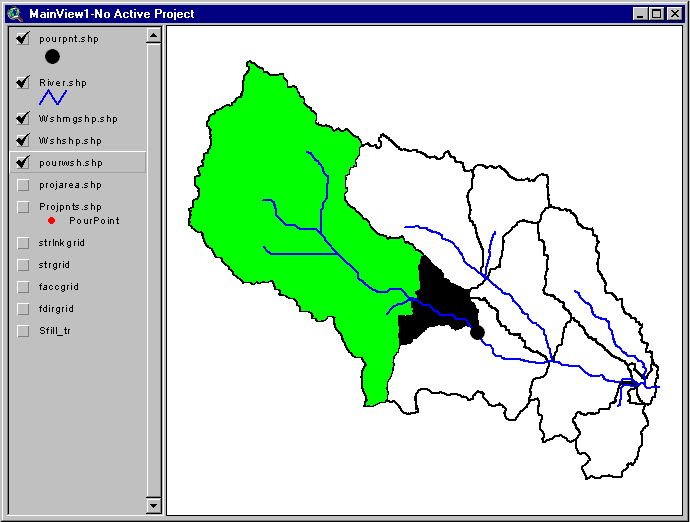
Figure 6. Identification of the local drainage area polygon (black polygon) and the upstream drainage area (lighter polygon).
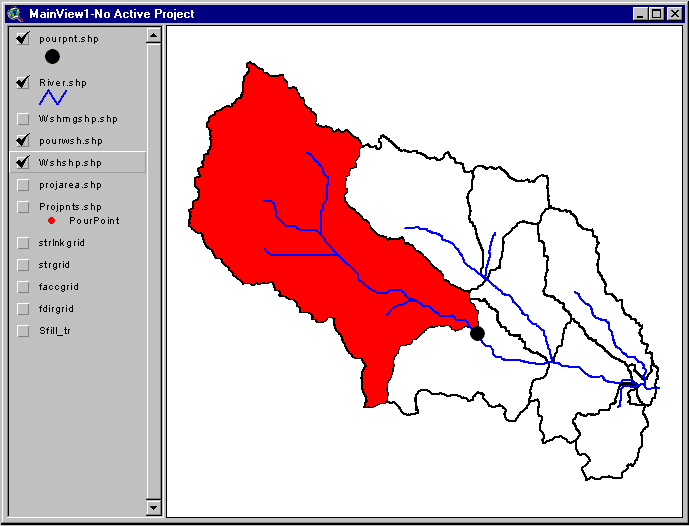
Figure 7. Final watershed for user defined point.
Implementation of this technique produces consistent execution times since only two polygons need to be added for any selected point (no addition is needed for points in head watersheds). There is a little variation due to different sizes of the subwatershed in which the point might reside (function of the threshold value used during the preprocessing and the shape characteristics of the watershed).
Techniques for other types of watershed delineation
The same principle can be used to delineate other types of watersheds. One of the common types of watershed delineation is determination of the surface area draining into a stream reach. This area does not include the upstream area draining into the upper end of the reach (Figure 8). Determination of such subwatershed is a simple application of the point delineation. The following process is performed:
This operation takes slightly more than twice the time it takes to compute a point watershed (due to the computation of the difference between the polygons).
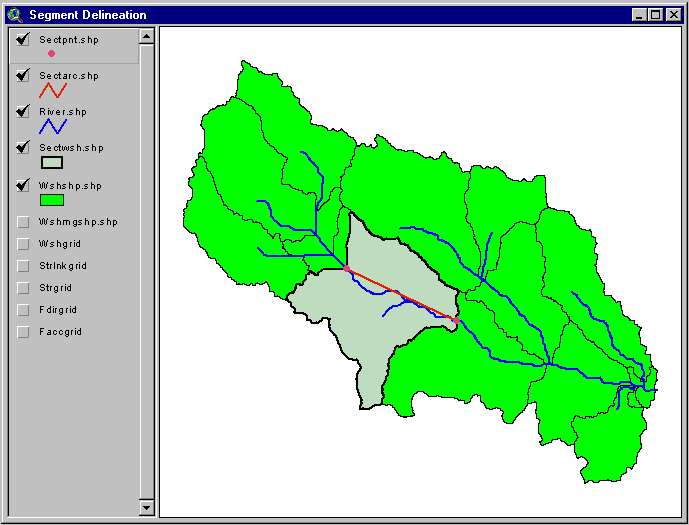
Figure 8. Segment delineation. Notice that if the segment contains a tributary stream, the contributing area of the tributary will be included in the segment watershed.
Another interesting watershed type is the area that drains through another area (as opposed to a point or a stream segment). This might be used to identify the surface area from which overland water washes over an area of interest (e.g. a city, a fire damaged area, etc.). Figure 9 shows an example.
|
|
|
Figure 9. Overview and a detail of polygon watershed delineation. Notice how the polygon of interest (dark area) spans the two initial subwatersheds. The light area indicates the watershed contributing to the flow over the polygon.
The technique for polygon delineation is slightly different than for the point and segment delineation, but is based on the same principle. The following steps are performed:
Notice that if the polygon intersects the stream system, the returned watershed will not include the area that drains to the upper intersection of the polygon with the stream. Physical interpretation is that the delineated watershed contains the area that directly contributes to the flow over the polygon, not through the polygon.
Performance Issues
Implementation of the above-described FWD methodology results in a consistent watershed delineation processing time. Figure 10 presents a graph showing the relationship between the processing time for a single point watershed and the DEM grid size without the FWD methodology. With the FWD methodology, the processing time varied between six (7) and nine (9) seconds regardless of DEM size. The computations were performed on Windows NT platform using a Pentium II 330 MHz processor and 128 MB of RAM.
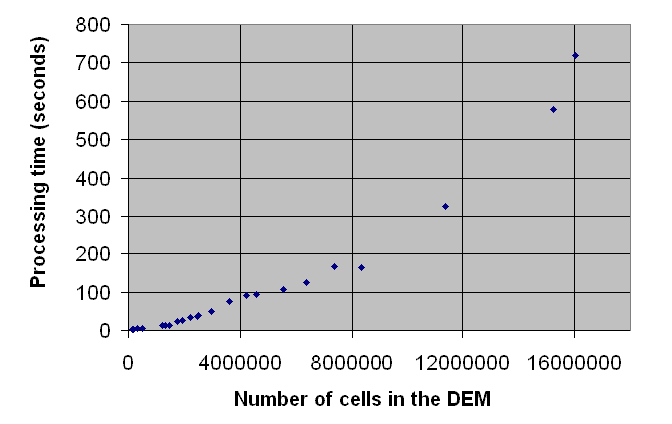
Figure 10. Relationship between processing time for a point watershed delineation and the DEM size (number of cells) without the FWD methodology (Pentium II 330 MHz processor and 128 MB of RAM).
Perez (1999) reports that for a DEM of approximately 250 million cells, processing of a single watershed took almost 3 hours using traditional method (no FWD) on a Sun Ultra 60 Model 2360 workstation. For the same DEM, with the FWD methodology, processing took about one minute on a Pentium 266Mhz machine. Actual performance for traditional method will depend mostly on the size of the DEM (number of cells) and the location of the point of interest, but will also depend on the shape of the DEM.
It is important to point out that for the traditional method, less preprocessing is required (only the flow direction grid is needed), so if only a handful of points are ever needed to be delineated, it is more feasible to use the traditional method. The preprocessing time needed to prepare the data for the watershed delineator technique can easily run into hours, and for large DEMs, even into days (Perez, 1999), but these operations are done only once for a given DEM. After preprocessing, the FWD methodology can be implemented on any computer without additional preprocessing.
Impact of the threshold size on the delineation process
The selection of the threshold has a twofold impact on the watershed delineation. The first aspect deals with the speed of delineation. If a large threshold is selected (relative to the size of the DEM), then few initial subwatersheds will be generated and the speed-up process will not be as efficient since the extracted grids will still be large (although the delineation will still be significantly faster than without the preprocessing).
The threshold selection and initial watershed subdelineation can/should be an iterative process. The threshold definition (stream definition) is performed after the flow direction and flow accumulation grids are determined (the two most time consuming operations), so not all the preprocessing steps need to be performed again. Also, the vector preprocessing does not have to be performed until the final threshold value is selected. The following process can be implemented:
The smaller threshold will result in a larger number of subwatersheds. This will speedup the delineation for a point (as the extracted flow direction grid is smaller), but will increase the time to perform all the required preprocessing steps, and will increase the size of the preprocessed themes (but not significantly). Since preprocessing is done only once, this is not a major issue. At some point, reducing the size of the subwatersheds will not return any benefits, as the overhead of grid extraction and polygon addition will become larger than the actual delineation within the subwatershed.
The second aspect of the threshold selection deals with issues related to the coastal and inner drainage basins. Using the current methodology, in order to define an initial subwatershed, a stream link needs to be present for that subwatershed. The stream link is a derivative of the stream, which in turn is defined by the threshold. For a large threshold, it is possible that smaller areas draining directly into the sea or a lake will not be identified (areas that drain less than the threshold value).
Figure 11 shows this issue on a North American HYDRO 1K dataset (USGS et al.). The cell size for the DEM is 1km. The DEM covering conterminous US contains 3184 rows by 4650 columns, for a total of about 14,800,000 cells. The selected threshold had 10,000 cells corresponding to 10,000 square kilometers (before a "stream" was identified). The DEM to threshold size ratio is about 1/1480 (significantly larger than the recommended starting point – resulting in a denser subwatershed theme) producing 411 subwatersheds, ranging in size from 10 to 120,000 cells. The time to perform point delineation is about four seconds.
Figure 11, focusing on the SE USA, shows that large portions of the coastal areas have not been predelineated. In these areas, the watershed delineation methodology can not be used, but rather the traditional method must be applied. To speed-up the delineation in those areas, a hybrid approach to watershed delineation can be implemented (using the same principle of limiting the extent of the grid that needs to be processed):
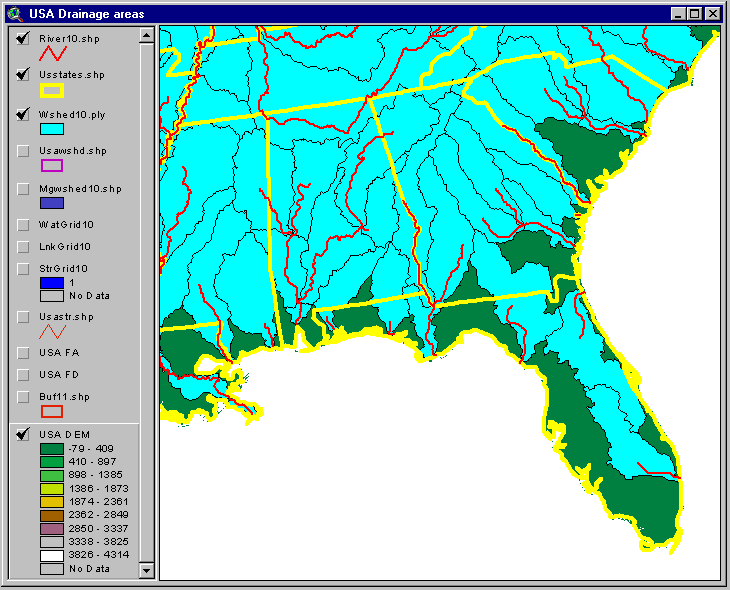
Figure 11. Threshold issues related to initial subwatershed delineation in coastal areas. The darker areas indicate watersheds not included in the set of predelineated subwatersheds.
The performance of this method for delineation in coastal areas will be similar to or faster than for the inner basins (since there is no need to add the upstream polygons). The inner basins (lakes) can be processed the same way.
Implementation of the watershed delineation methodology
The described methodology was first implemented in the Watershed Delineator (Esri, 1997). The Watershed Delineator is a public domain ArcView extension (requires ArcView Spatial Analyst extension) that Esri developed for the Texas Natural Resource Conservation Commission, with the sole purpose of efficiently delineating watersheds. The extension contains all the necessary tools for FWD methodology implementation, including preprocessing and watershed delineation. The watersheds for points, segments, or polygons can be delineated either interactively or in the batch mode where the data of interest are provided to the application in the form of shape files.
Currently Esri and HEC are using this approach in developing another ArcView extension whose focus is interactive watershed development for hydrologic modeling support. Besides watershed delineation, this extension will have tools for topographic characteristic extraction, hydrologic parameter definition, and model input file generation, similar to CRWR-PrePro (Olivera and Maidment, 1999).
From the watershed delineation point of view, the key difference is that the final result of the application is a set of non-overlapping subwatersheds, of which each one will be modeled as a hydrologic unit. The described watershed delineation methodology is used to identify the area of interest for which the hydrologic modeling will be performed. Once this area is identified, a set of interactive tools are made available for refinement of the initial delineation (merge and split current subwatershed, add sub-basin outlet points from a file, etc.). The core delineation functions (point, segment, and polygon) will also be included with this application to provide a full set of delineation tools.
Conclusion
The FWD methodology described in this paper allows efficient and consistent watershed delineation on DEMs of any size. The speed of delineation can be controlled by the user during the preprocessing stages, and can be in the order of five to ten seconds per watershed on most of today’s desktop systems, allowing for a truly interactive operation. The required preprocessing needs to be done only once for a given DEM and can be done at a different location from the one where the actual delineation work will be performed. This allows preprocessing of regional datasets that are then distributed to the end users who can immediately apply to delineation tools on that dataset.
The FWD methodology and the tools developed for its implementation are only effective if a good quality DEM is available. The "quality" of a DEM is a function of the scale and the task at hand. The described methodology promotes development of quality data as these issues have to be addressed sooner (during the preprocessing stages) rather than later (during watershed delineation). These issues can then be focused on a group of experienced analysts, instead of end users who are not versed in intricacies of terrain representation using DEM structures.
Acknowledgments
The Watershed Delineation application that prompted initial development of FWD methodology was built by Esri for the Texas Natural Resource Conservation Commission (Austin, TX) under the WIPS grant from the Environmental Protection Agency.
The current implementation of the methodology is under the CRADA agreement between Esri and US Army Corps of Engineers Hydrologic Engineering Center (Davis, CA).
References
Cederstrand, J.R., and A. Rea. (1995), Watershed boundaries and digital elevation model of Oklahoma derived from 1:100,000-scale digital topographic maps, U.S. Geological Survey Open-File Report 95-727
Djokic, D., Z. Ye, and A. Miller. (1997), Efficient Watershed Delineation Using ArcView and Spatial Analyst, Proc. 17th Annual Esri User Conference, San Diego, CA.
Esri. (1997), Watershed Delineator Application - User's Manual, Environmental Systems Research Institute, Redlands, CA.
Garbrecht, J., and L.W. Martz. (1999), Digital Elevation Model Issues in Water Resources Modeling, Proceedings of the 19th Esri Users Conference, San Diego, CA (this issue).
Olivera, F., and D.R. Maidment. (1999), GIS Tools for HMS Modeling Support, Proceedings of the 19th Esri Users Conference, San Diego, CA (this issue).
Perez, A. (1999), Source Water Protection Project: A comparison of Watershed Delineation Methods in ARC/INFO and ArcView, Proceedings of the 19th Esri Users Conference, San Diego, CA (this issue).
USGS EROS Data Center, HYDRO 1K Elevation Derivative Database,
http://edcwww.cr.usgs.gov/landdaac/gtopo30/hydro/
Author Information
|
Dean Djokic Senior Applications Programmer and Consultant Esri 380 New York St. Redlands, CA 92373 Tel. 909-793-2853 ext. 1072 Fax. 909-307-3014 Email. ddjokic@Esri.com |
Zichuan Ye Applications Programmer Esri 380 New York St. Redlands, CA 92373 Tel. 909-793-2853 ext. 1505 Fax. 909-307-3014 Email. zye@Esri.com |